Turning Strategy Into Reality: An 8-Step Guide to Achieving Success
Every successful business needs a solid strategy to grow and thrive. However, developing a comprehensive and effective strategy can be challenging and overwhelming for any business, large or small. With new technologies and capabilities emerging every day, it's easy to get lost in the complexity of it all.
I have formulated a simple eight-step process that will ensure you go from strategy to success, and will provide your business with a clear path to achieving its goals.
Step 1: Engage a Strategy Consultant
The first step in developing a successful strategy is to engage a strategy consultant. These professionals will help you identify your goals and objectives, analyse market trends, and evaluate your competition. Based on their analysis, they will develop a strategic plan for your business. A strategy consultant will bring an objective perspective to your business, allowing you to see things that you may have missed on your own.
Step 2: Engage Your Team During Strategy Creation
Your team is a crucial part of your business, and their input is invaluable during the strategy creation process. It's essential to communicate the strategic plan to your team and encourage their feedback and insights. Incorporating your team's suggestions and ideas will help ensure that your plan is feasible and executable. Be sure to also evaluate your team's capabilities to execute the strategy.
Step 3: Get Your Draft Strategy Approved
Once your strategic plan has been developed, it's essential to get approval from all stakeholders, including your team, investors, and board members. You'll need to refine and adjust the plan as necessary to ensure alignment with organisational capabilities.
Seeking approval and feedback early on in the process will enhance collaboration and ultimately guarantee a smooth adjustment period as you execute next steps.
Step 4: Bring in Your Strategy Execution Team
At this stage, you'll need to bring in an external team to execute your strategy. The execution team will help you assign priorities, establish timelines, and allocate resources and budgets accordingly. You'll need to ensure that the execution team's roles and responsibilities align with the strategic plan.
Keep in mind that the team who did your strategy will probably not be the same team to run your implementation project. It’s like using your Architect to manage your house build. You can do it, but you’ll pay a lot more and they don’t specialise in it.
Step 5: Create a Delivery Roadmap and Project Priority
When your future state is clear, your project execution team will create a delivery roadmap and project priority based on your strategic objectives. They will help you prioritise your projects and allocate resources and budgets accordingly.
Roadmapping your deliverables and prioritising the stages of your strategy are essential to minimising delays, preparing for obstacles and reaching your goals without further costs to your organisation.
Keep in mind that the roadmap may change over the course of the program, but a strong delivery team will help you to understand your new target state and manage the delivery with minimal risk to the business.
Step 6: Get Board Approval
You'll need to present your strategic plan and project roadmap to the board and obtain approval and support. Come prepared with data supporting your decisions and ready for questions concerning costs and outcomes.
You'll then communicate their decision to the execution team, and make any adjustments that the board has requested.
Step 7: Finalise Quotes
To execute your strategy successfully, you'll need to finalise quotes for all necessary resources, materials, and services. Negotiate with vendors to ensure that your budget and resources align with your strategic plan.
Step 8: Execute and Monitor Progress
Finally, it's time to execute your strategy. Ensure that your execution plan aligns with your strategic plan and priorities throughout the delivery.
Monitor and record progress, communicating updates with your team regularly.
Engage Your Team to Avoid Pitfalls
While every step in this eight-step process is crucial, I believe that step two is the most critical. Engaging your team during the strategy creation process is essential to identify potential risks and challenges. Your team will help you spot technology limitations, organisational misalignment, skill gaps, and other issues that could hinder your strategy's success. Skipping this step could lead to costly mistakes down the road.
Developing a successful strategy is critical for any business that wants to grow and thrive. By following this eight-step process, you can create a clear path to success for your business. Remember to engage your team, get approval from stakeholders, and monitor progress regularly. With a solid strategy in place and a dedicated team to execute it, your business can achieve its goals and reach greater levels of success.


